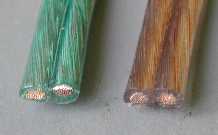Karl H
Senior Member
- Location
- San Diego,CA
Got a call to trouble-shoot some track lighting that wasn't working in a
large design facility today. 12v Alfa tracks, all fed with what appears to be
#10 alum clad copper or tinned copper stranded, with a transparent outer
sheathing. It looks like and I believe it to be 10AWG speaker wire. There
are no numbers,manufacture,type letters, or UL on the wires at all. Due to
brittle or burned condition of the outer sheathing, it is definitely not suited
for the high current low volt system it is supplying. I've tried looking it
up but, I've yet to find a type letter or an ampacity rating of the insulation
commonly used on speaker wire. Does anyone know what type of insulation
speaker wire uses.
The wires will be replaced with a suitable LV cable. I'm just curious what the rating is for speaker wire. Sorry no pics.
BTW there are 90 tracks wired in this manner. Physics exposes Ignorance!
:grin:
large design facility today. 12v Alfa tracks, all fed with what appears to be
#10 alum clad copper or tinned copper stranded, with a transparent outer
sheathing. It looks like and I believe it to be 10AWG speaker wire. There
are no numbers,manufacture,type letters, or UL on the wires at all. Due to
brittle or burned condition of the outer sheathing, it is definitely not suited
for the high current low volt system it is supplying. I've tried looking it
up but, I've yet to find a type letter or an ampacity rating of the insulation
commonly used on speaker wire. Does anyone know what type of insulation
speaker wire uses.
The wires will be replaced with a suitable LV cable. I'm just curious what the rating is for speaker wire. Sorry no pics.
BTW there are 90 tracks wired in this manner. Physics exposes Ignorance!
:grin:


